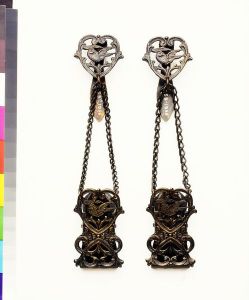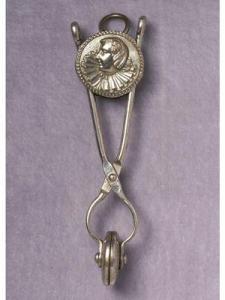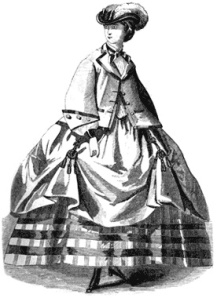I am an avid period drama fan, but I have often wondered how it is these ladies with their long (sometimes fancy, sometimes not) skirts never seem to get the least bit dirty. If it were me, I would have dirt on anything that reached past my ankles. Well, this little device is one way to keep your long flowing skirts free from the muck of the ground. These are called skirt grips (or dress holders, skirt lifters, skirt elevators etc). Their use started around the 1840s with their peak hitting between 1860 and 1880.
The particular skirt grip above originated in London, England and was patented in 1902 by Brendal, B.O. This pair (according to V&A Museum) have a pointed piece of metal at the top to allow it to be inserted over a belt or waistband and serrated clips at the bottom to hold the skirt material. In this case, it is likely that these skirt grips were used for exercise as the serrated clips would work best with everyday fabrics like wool and would have injured more fine fabrics like silk.
Another common type of skirt grip was shaped more like tongs that would have a spot at the top for a chain or cord that would allow it to suspend off of the belt or waist allowing it to be easily adjustable with the end of the tongs clamping down on the hem of the skirt. Where the other set of skirt grips would have injured nicer material, this skirt grip would be best suited for fabrics such as silk. Just for fun, here are a few examples of skirt grip names: ‘Bicycle’, ‘Eureka’, ‘The Grappler’, ‘Invincible’, ‘The Automatic’. They were named as such to provide ladies a way to distinguish which grip would be best for the material they would be using it on. I’m thinking I would totally buy the Grappler just because of the name.
Skirt grips could be worn in pairs or just one single grip, though the single grip (usually worn to the right side) was more popular. Skirt grips, no doubt, were enjoyed for their practical use, but as you might guess from how ornate the above grips are, they served as a decorative piece in the ensemble as well. Not only were the grips themselves ornate, but they also helped the wearer mimic a very popular fashion revival of the polonaise style http://en.wikipedia.org/wiki/Polonaise_(clothing). In a nutshell, this was where the overskirt was raised in some fashion to allow the bottom part of the underskirt to show. The picture below is a pretty good representation of this style with the pair of skirt grips holding up the overskirt to show the patterned underskirt.
Civil War Era Ladies’ Dresses – March 1861 Peterson’s Magazine
What I really like about this particular object is that it is decorative but also useful. As women began to partake in more and more rigorous and/or outdoor activities, the need for more practical attire arose and these little guys stepped up to the challenge (or rather their inventors did). It’s interesting to be able to see directly how an object reflects a shift in culture, even if it is as slight as women beginning to take on more active past times.
If you are just fascinated by these clever little devices, there is a book about them, A History of Victorian Skirt Grips, by Mary Sawdon. I haven’t read it, so I cannot vouch for it, but it’s something to look into nonetheless.



